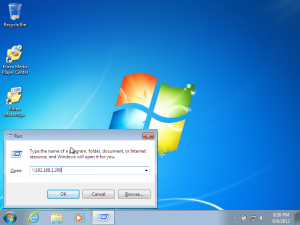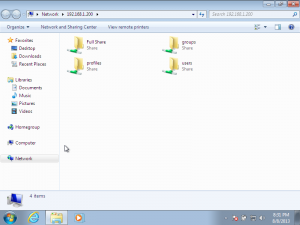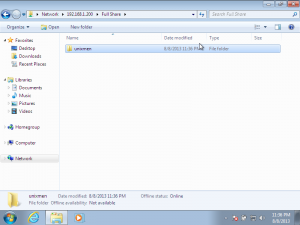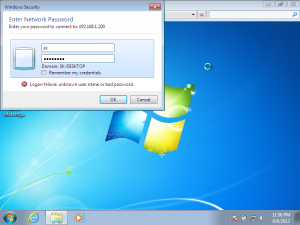linux Samba 搭建
Samba is a free and open-source software package that provides seamless file and print services to SMB/CIFS clients. Samba is freely available, unlike other SMB/CIFS implementations and allows for interoperability between Linux/Unix servers and Windows OS-based clients. Using Samba we can easily share files and folders between GNU/Linux and Windows OS systems.
In this tutorial we are going to implement Samba server on OpenSUSE 13.1.
Install Samba
Login as root user:
> su
Install Samba with following command:
# zypper install samba*
Configure Fully Accessed Anonymous Share
Let us create directory /share1 and set full permission. Anybody can access this share:
# mkdir /share1
# chmod -R 777 /share1/
Open up Samba configuration file /etc/samaba/smb.conf file:
# vi /etc/samba/smb.conf
And edit as follows;
Make sure that you have the following line in [global] section. If not found, just add it as shown below:
[...]
passdb backend = tdbsam
[...]
Scroll down further and add this share details at the bottom of the Samba configuration file:
[Full Share]
path = /share1
writable = yes
browsable = yes
guest ok = yes
guest only = yes
create mode = 0777
directory mode = 0777
Save and close the file. Enable and start Samba service to save the changes:
# systemctl enable smb.service
# systemctl enable nmb.service # systemctl start smb.service
# systemctl start nmb.service
Test Samba Configuration
Execute the following command to verify the Samba configuration file. It displays the errors if we have any:
# testparm
The above command will display the output as shown below:
Load smb config files from /etc/samba/smb.conf
rlimit_max: increasing rlimit_max (1024) to minimum Windows limit (16384)
Can't find include file /etc/samba/dhcp.conf
Processing section "[homes]"
Processing section "[profiles]"
Processing section "[users]"
Processing section "[groups]"
Processing section "[printers]"
Processing section "[print$]"
Processing section "[Full Share]"
Loaded services file OK.
Server role: ROLE_STANDALONE
Press enter to see a dump of your service definitions [global]
map to guest = Bad User
printcap name = cups
logon path = \\%L\profiles\.msprofile
logon drive = P:
logon home = \\%L\%U\.9xprofile
usershare allow guests = Yes
idmap config * : backend = tdb
cups options = raw [homes]
comment = Home Directories
valid users = %S, %D%w%S
read only = No
inherit acls = Yes
browseable = No [profiles]
comment = Network Profiles Service
path = %H
read only = No
create mask = 0600
directory mask = 0700
store dos attributes = Yes [users]
comment = All users
path = /home
read only = No
inherit acls = Yes
veto files = /aquota.user/groups/shares/ [groups]
comment = All groups
path = /home/groups
read only = No
inherit acls = Yes [printers]
comment = All Printers
path = /var/tmp
create mask = 0600
printable = Yes
print ok = Yes
browseable = No [print$]
comment = Printer Drivers
path = /var/lib/samba/drivers
write list = @ntadmin, root
force group = ntadmin
create mask = 0664
directory mask = 0775 [Full Share]
path = /share1
read only = No
create mask = 0777
directory mask = 0777
guest only = Yes
guest ok = Yes
I don’t want to mess up iptables, so i turned it off:
# rcSuSEfirewall2 stop
Test Anonymous Samba Share on Windows OS Client
Login to Windows OS machine and go to Start -> Run. Enter the IP address of your Samba server.
 Now you’ll able to access the fully accessed Samba share from your Windows OS clients.
Now you’ll able to access the fully accessed Samba share from your Windows OS clients.
 Create some files and folders in side the share. In my case, I created a folder called unixmen in my fully accessed anonymous Samba share called Full Share.
Create some files and folders in side the share. In my case, I created a folder called unixmen in my fully accessed anonymous Samba share called Full Share.
 Create an Authenticated Share
Create an Authenticated Share
Let us create a Samba user called sk under Samba group called smbgroup:
# useradd sk
# passwd sk # groupadd smbgroup
# usermod -a -G smbgroup sk
Now assign the user sk to Samba user database with following command:
# smbpasswd -a sk
New SMB password:
Retype new SMB password:
Added user sk.
Create a new share called /share2 and assign this share to smbgroup, so that the users of smbgroup can access the /share2 directory:
# mkdir /share2
# chmod -R 755 /share2/
# chown -R sk:smbgroup /share2
Add the above /share2 directory details in Samba configuration file as shown below;
Open up samba configuration file:
# vi /etc/samba/smb.conf
Add the /share2 details at the end:
[secure]
path = /share2
writable = yes
browsable = yes
guest ok = no
valid users = @smbgroup
Restart Samba service to save the changes:
# systemctl restart smb.service
# systemctl restart nmb.service
Now test the configuration file with following command:
# testparm
You may see the following like output:
Load smb config files from /etc/samba/smb.conf
rlimit_max: increasing rlimit_max (1024) to minimum Windows limit (16384)
Can't find include file /etc/samba/dhcp.conf
Processing section "[homes]"
Processing section "[profiles]"
Processing section "[users]"
Processing section "[groups]"
Processing section "[printers]"
Processing section "[print$]"
Processing section "[Full Share]"
Processing section "[secure]"
Loaded services file OK.
Server role: ROLE_STANDALONE
Press enter to see a dump of your service definitions [global]
map to guest = Bad User
printcap name = cups
logon path = \\%L\profiles\.msprofile
logon drive = P:
logon home = \\%L\%U\.9xprofile
usershare allow guests = Yes
idmap config * : backend = tdb
cups options = raw [homes]
comment = Home Directories
valid users = %S, %D%w%S
read only = No
inherit acls = Yes
browseable = No [profiles]
comment = Network Profiles Service
path = %H
read only = No
create mask = 0600
directory mask = 0700
store dos attributes = Yes [users]
comment = All users
path = /home
read only = No
inherit acls = Yes
veto files = /aquota.user/groups/shares/ [groups]
comment = All groups
path = /home/groups
read only = No
inherit acls = Yes [printers]
comment = All Printers
path = /var/tmp
create mask = 0600
printable = Yes
print ok = Yes
browseable = No [print$]
comment = Printer Drivers
path = /var/lib/samba/drivers
write list = @ntadmin, root
force group = ntadmin
create mask = 0664
directory mask = 0775 [Full Share]
path = /share1
read only = No
create mask = 0777
directory mask = 0777
guest only = Yes
guest ok = Yes [secure]
path = /share2
valid users = @smbgroup
read only = No
Test Authenticated Share on Windows OS Client
Now go to the Windows OS client and check the authenticated share. It will ask you to enter username and password to access the Samba shares. Enter the username and password that you have created earlier. You’re done!
 That’s it. Now you’ll able to access the Samba shares.
That’s it. Now you’ll able to access the Samba shares.
转:https://www.unixmen.com/install-and-configure-samba-server-on-opensuse-13-1/
linux Samba 搭建的更多相关文章
- 【转帖】Linux上搭建Samba,实现windows与Linux文件数据同步
Linux上搭建Samba,实现windows与Linux文件数据同步 2018年06月09日 :: m_nanle_xiaobudiu 阅读数 15812更多 分类专栏: Linux Samba 版 ...
- Samba搭建Linux和Windows文件共享服务
一.Samba简介 Samba是在Linux和UNIX系统上实现SMB协议的一个免费软件,由服务器及客户端程序构成.SMB(Server Messages Block,信息服务块)是一种在局域网上共享 ...
- Linux服务器搭建相关教程链接整理
Linux: Linux 教程 | 菜鸟教程 linux下如何添加一个用户并且让用户获得root权限 - !canfly - 博客园 Git: 在 Linux 下搭建 Git 服务器 - 黄棣-dee ...
- Linux samba多用户挂载
samba 多用户挂载 通过multiuser挂载选项,使用基于密码验证和cifscreds实现访问控制在默认情况下,samba共享挂载后,是通过挂载时的验证来实现对挂载资源的访问控制.通过新的mul ...
- Linux Samba安装与使用
一 安装环境: 虚拟机:RedHat 5.4 192.168.75.128 主机环境:WIN7 32bit 192.168.75.1 网络连接方式:NAT 二 安装步骤: 说明: Ø samb ...
- Linux环境搭建-在虚拟机中安装Centos7.0
最近在空闲时间学习Linux环境中各种服务的安装与配置,都属于入门级别的,这里把所有的学习过程记录下来,和大家一起分享. 我的电脑系统是win7,所以我需要在win7上安装一个虚拟机-VMware,然 ...
- windows和linux中搭建python集成开发环境IDE——如何设置多个python环境
本系列分为两篇: 1.[转]windows和linux中搭建python集成开发环境IDE 2.[转]linux和windows下安装python集成开发环境及其python包 3.windows和l ...
- MongoDB学习笔记—Linux下搭建MongoDB环境
1.MongoDB简单说明 a MongoDB是由C++语言编写的一个基于分布式文件存储的开源数据库系统,它的目的在于为WEB应用提供可扩展的高性能数据存储解决方案. b MongoDB是一个介于关系 ...
- Linux下搭建个人网站
前不久在阿里买了一个服务器,然后开始第一次尝试搭建自己的个人网站.前端采用了bootstrap框架,后端采用的是PHP,数据库使用的是Mysql.新手第一次在linux下搭建遇见很多问题,在这里分享一 ...
随机推荐
- os用法总结:python中必须掌握的内置模块os,实现与计算机操作系统的常规交互!
os模块说明 ''' os 模块 Os库是python标准库,包含几百个函数 常用路径操作.进程管理.环境参数等几类 路径操作:os.path子库,处理文件路径及信息 进程管理:启动系统中其他程序 环 ...
- MySQL实战45讲(10--15)-笔记
11 | 怎么给字符串字段加索引? 维护一个支持邮箱登录的系统,用户表是这么定义的: mysql> create table SUser( ID bigint unsigned primary ...
- JVM详解(四)——类加载过程
类加载过程 https://www.cnblogs.com/aqsaycode/p/14885023.html
- 一文读懂Redis
目录结构如下: 简介 Redis是一个高性能的key-value数据库.Redis对数据的操作都是原子性的. 优缺点 优点: 基于内存操作,内存读写速度快. Redis是单线程的,避免线程切换开销及多 ...
- 解析Prometheus PromQL
解析PromQL 目前对Prometheus 的promQL 的解析文章比较少,且Prometheus官方也没有提供一个公共的库来对齐进行解析.下面实现对promQL的解析,并实现注入label功能. ...
- freeswitch刷新网关方法
1.freeswitch xml配置文件新增网关后,使其生效,可以重启freeswitch或者使用命令方式 fs_cli -H 127.0.0.1 -P 8021 -p hmzj -x sofia p ...
- 利用k8s yaml配置文件起一个http能够让外部访问
1.首先建一个http的Deployment apiVersion: apps/v1 #版本信息 kind: Deployment #文件类型 metadata: #Deployment资源的元数据信 ...
- pytest+allure基础知识
介绍 pytest是基于unittest开发的另一款更高级更好用的单元测试框架 支持参数化 执行测试过程中可以将某些测试跳过(skip),或者对某些预期失败的case标记成失败 支持运行由 nose, ...
- 一文详解JavaScript的继承模式
1 原型链继承 #### ES6中通过原型继承多个引用类型的属性和方法,由于原型和实例的关系,即每个构造函数都有自己的原型对象,同时原型有一个属性指向构造函数,并且实例有一个内部的指针指向原型.如果存 ...
- 【PHP数据结构】散列表查找
上篇文章的查找是不是有意犹未尽的感觉呢?因为我们是真真正正地接触到了时间复杂度的优化.从线性查找的 O(n) 直接优化到了折半查找的 O(logN) ,绝对是一个质的飞跃.但是,我们的折半查找最核心的 ...
